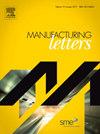Stereolithography-assisted sodium alginate-collagen hydrogel scaffold with molded internal channels
IF 2
Q3 ENGINEERING, MANUFACTURING
引用次数: 0
Abstract
Fabricating internal vascular networks within a hydrogel scaffold is essential for facilitating the supply of nutrients, oxygen, and metabolism exchange required by the encapsulated cells. The challenges in current hydrogel scaffold fabrication involve the difficulty of building adequate internal channels, poor scaffold geometry precision, and low cell viability caused by the fabrication process and polymer material properties. Stereolithography (SLA) stands out as a 3D printing technique distinguished by its superior production efficiency, advanced precision, and remarkable resolution in crafting intricate custom geometries. These attributes establish it as an innovative approach for templates in scaffold fabrication, potentially surpassing the fused deposition modeling (FDM)-based template strategy. Meanwhile, it exerts less shear stress on the cells compared to the direct bioprinting process. This novel strategy enables the fabrication of hydrogel vascular structure within the precision of 500 µm in both channel diameter and wall thickness. In this paper, various sodium alginate and collagen (SA-Col) composite hydrogels with varying collagen concentrations have been investigated to identify the optimal ratio for fabricating hydrogel scaffolds with channels.
立体光刻辅助海藻酸钠-胶原蛋白水凝胶支架与模塑内部通道
在水凝胶支架内构建内部血管网络对于促进包裹细胞所需的营养、氧气供应和新陈代谢交换至关重要。目前水凝胶支架制造所面临的挑战包括:难以建立足够的内部通道、支架几何精度差,以及制造工艺和聚合物材料特性导致的细胞存活率低。立体光刻(SLA)作为一种三维打印技术,以其卓越的生产效率、先进的精度和出色的分辨率在制作复杂的定制几何形状方面脱颖而出。这些特性使其成为支架制造模板的创新方法,有可能超越基于熔融沉积建模(FDM)的模板策略。同时,与直接生物打印工艺相比,它对细胞施加的剪切应力更小。这种新颖的策略使水凝胶血管结构的通道直径和壁厚精度都控制在 500 微米以内。本文研究了不同浓度的海藻酸钠和胶原蛋白(SA-Col)复合水凝胶,以确定制造带通道水凝胶支架的最佳比例。
本文章由计算机程序翻译,如有差异,请以英文原文为准。
求助全文
约1分钟内获得全文
求助全文
来源期刊

Manufacturing Letters
Engineering-Industrial and Manufacturing Engineering
CiteScore
4.20
自引率
5.10%
发文量
192
审稿时长
60 days
 求助内容:
求助内容: 应助结果提醒方式:
应助结果提醒方式:


